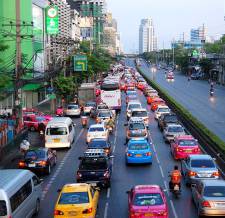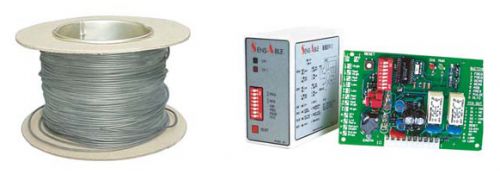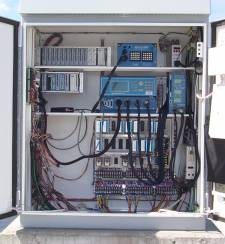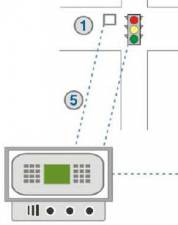Urban sprawl and a lack of public transportation infrastructure have led to ever increasing traffic congestion, as people commute to most of their daily activities. Traffic-actuated signals have been created to alleviate this problem by efficiently managing traffic flow. The system is capable of detecting live traffic data and assigning the appropriate light cycle (for instance, turning on green lights at a desired time). The system is composed of a detector and a controller. A detector collects live traffic data, which the controller uses to decide the traffic light cycle that drivers will respond to. With regularly scheduled maintenance, this system should be able to run for many years with no problems. Traffic-actuated signals can improve traffic congestion by responding to road conditions as problems occur.
Introduction
The United States has evolved into a society of commuters due to the rate of urban sprawl or city development. Many residents have to drive every day to work or school, and getting stuck in traffic is a frustratingly common experience for most. A bigger concern may be the fact that major cities do not have public transportation systems that cover the large suburban area, forcing people to rely more heavily on their automobiles. As a result, the high usage of automobiles and other vehicles on the road causes daily traffic congestion and delays.
Traffic congestion is created by a large number of vehicles on the road at the same time. When a road reaches its maximum vehicle capacity, traffic flows inefficiently. Traffic engineers have concluded that while a reduction in the number of automobiles would alleviate the problem in the long-term, a more efficient short-term solution is necessary. Therefore, engineers have developed, implemented, and perfected a new system that operates traffic signals. These traffic-actuated control systems adapt to the volume of traffic and provide the most efficient cycle of green lights as well as adequate cycle duration.
Purpose of Traffic Signals
Initially, traffic signals were created to prevent car accidents by assigning the right of way to vehicles headed in different directions. Over time, signals were also used to provide safety for pedestrians and bicyclists. However, the number of pedestrians has decreased while the number of vehicles has increased, resulting in busy streets and highways. Thus, the purpose of traffic lights has evolved to manage the flow of vehicle traffic in an efficient manner in order to alleviate congestion, while still continuing to provide safety for pedestrians and bicyclists [3].
Traffic-Actuated Signals
Due to the rapid increase in the number of automobiles in the U.S., the old traffic signal system had to be improved to be able to maintain an efficient flow of vehicles. The new system, called a traffic-actuated controller, operates by adapting to the volume of vehicles on the road. This system does not set a timer for the cycle of signals, but instead measures the volume of vehicles on the road at any given moment and then sets the frequency and interval of traffic lights accordingly.
The system has three basic components: a detector, a controller unit, and the signal heads (traffic lights). The purpose of a detector is to detect the presence and volume of vehicles on the road. There are many different types, including the inductive loop, magnetometer, magnetic, and microwave radar detectors. According to Myer Kutz, author of the Handbook of Transportation Engineering, “the inductive loop detector is by far the most common form of detector used for both traffic counting and traffic management purposes. It is used to measure traffic volume, flow rate, vehicle speed, and occupancy” [1]. An inductive loop detector has loops of insulated wires that interpret changes in the electrical properties of the loop when a vehicle passes over it (see Fig. 1). Installed under the pavement, this detector (see Fig. 2) can accurately measure the density of traffic and presence of congestion [1].
The second component, the controller (see Fig. 3), is the brain of the system, as it takes data provided by the detector and decides the frequency and duration of the next signal cycle. There are two types of controllers that are used for different traffic-flow settings: semi-actuated and full-actuated. Semi-actuated controllers are used for major roads that have a constant flow of traffic throughout the day. Their main function is to prioritize traffic on bigger roads by controlling the light intervals of smaller roads. They receive information from detectors installed on small roads so that they are able to give the right of way to vehicles on the smaller streets when necessary, while keeping minimal disruption to the flow on the larger street.
The second type, the full-actuated controller, is used for roads that have fluctuating patterns in the volume of vehicles throughout the day, such as roads heavily-trafficked during rush hour. This type of controller is the most preferred because of its accuracy and efficiency. The system requires detectors on every road in every direction, allowing it to have comprehensive traffic information. Based on this data, the system is able to prioritize the right of way as needed. Moreover, the controller will establish the cycle and green light time that is necessary in order to maintain the most efficient flow of traffic in the area [6].
The third and last component, signal heads, also known as traffic lights, provide visual representation to drivers by illuminating lights in three different colors: red, yellow, and green. Each color delivers a different message to drivers: red means stop, yellow means prepare to stop, and green means proceed. In addition, a traffic light also has a sign for protected left and right turns, which are presented by the same colors as the normal signals but in arrow shapes. [2]
When the functions of each component are put together, a traffic system works properly (see Fig. 4). A detector senses the presence and volume of vehicles and transmits this data to the controller, which will establish the cycle of green lights in accordance with various traffic conditions. The result of this process is displayed by a traffic light, which communicates the correct actions to the drivers [2].
Maintenance of Traffic Signals
For a traffic signal to function effectively, scheduled maintenance is required to prevent or eliminate malfunctions. Oftentimes, the scheduled maintenance is delayed or canceled due to budget cuts. However, keeping up with regular maintenance is actually more cost-effective in the long term, because it allows for longer equipment lifetimes and less system downtime. There are three categories of maintenance: preventive, responsive, and design modification. The goal of preventive maintenance is to ensure that the system continues to operate in good condition. This maintenance consists of inspecting hardware and software. Through the inspection, dirty elements are cleaned, components are adjusted or tuned, and parts are replaced if necessary. For example, signal lenses are cleaned, lamps are replaced, and detectors and controllers are tuned through preventive maintenance. Failure to meet these requirements could cause malfunction in the system. For instance, if detectors fail, the controllers will become useless and the signals will not adjust to traffic conditions.
Besides the basic equipment upkeep, there is a need for responsive maintenance that troubleshoots and repairs the system after it malfunctions. Budget cuts to regular preventative maintenance have made responsive maintenance the most common type. It is important that responsive maintenance of this type is completed in a timely manner, because a broken traffic signal causes even more congestion than no signal at all. A record is kept of all such incidents so that any malfunction patterns can be noticed and potential corrective action taken before they occur next.
Lastly, design modification consists of changing signal displays, timing plans, and equipment to reflect changing traffic conditions in different areas over time. Such work is done upon requests of the drivers. For example, when signals are not visible because of a glare from the sunlight, or when bulbs need to be brighter, the system can be updated so it best serves the drivers that use it. When all three types of maintenance are done properly, traffic signals will function effectively over a long period of time [3].
Conclusion
With the number of passenger vehicles constantly on the rise, traffic congestion is becoming a major part of any urban or even suburban lifestyle. In response to driver frustration, traffic engineers create technology like the traffic-actuated controller system. Easing traffic also cuts the time an individual car spends during a normal commute, reducing gasoline usage. Even though traffic jams are still a common occurrence, traffic-actuated signals have made significant contributions in improving road conditions since their development. Without these silent sentinels at every crossroad, your morning commute would be even longer. To continue to ease the problem of traffic congestion, engineers need to make a continued effort to improve roads and signal systems.






